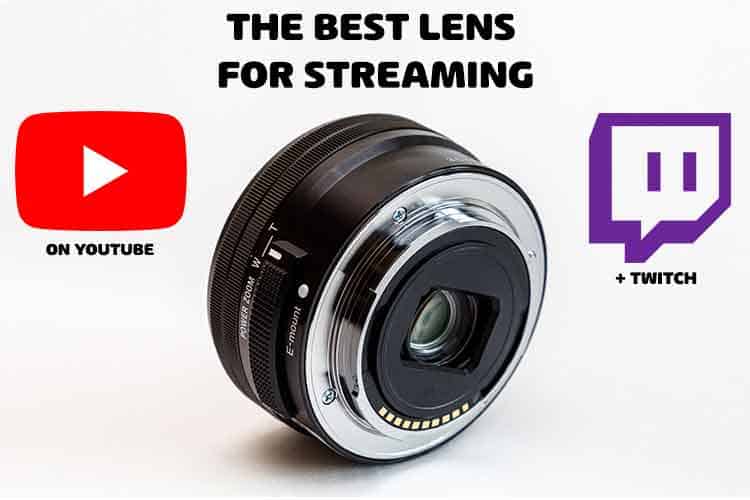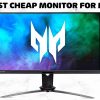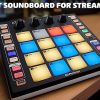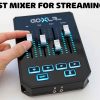If you’re in search of the best lens for streaming then you’ve come to the right place.
Understanding camera lenses is not exactly the easiest topic to get your head around, especially if you have fairly limited background knowledge in photography.
Each lens has many different variables that will ultimately determine the outcome of the shot. Choosing the right lens will depend on concepts relating to the image quality, including the focal length, aperture, and more…
In the post, we will not only cover the basics of buying a lens but also provide video examples of the lenses popular streamers use.
How to choose a lens for streaming?
When shopping for a new lens, the most important factors you need to consider are the focal length, aperture, and sensor size.
1. Focal Length
The focal length is measured in millimeters (eg. 24mm). It determines the angle of view (how wide your background will look) and the magnification (how large the streamer is going to appear).
A shorter focal length (e.g. 12mm) creates a more zoomed-out shot, whereas a longer focal length (e.g. 50mm) produces a more zoomed-in shot. Therefore, a 12mm focal length is going to have a wider field of view than a 50mm lens, which will have a narrower field of view.
If the lens has two numbers (eg. 16-50mm), this indicates that the lens has a variable focal length (not fixed) and can be set to 16mm, 50mm, or anywhere in between. A “zoom lens” is particularly useful for new streamers who are unsure of what focal length is best for them.
Deciding what focal length is best for you, will largely be down to the distance you plan on placing the camera lens away from yourself and how much “scene” you want in the picture.
Unfortunately, we can’t tell you the exact distance you need for each focal length as this is hard to calculate. It will depend on your size, how much ”scene” you want in the picture, and whether you are using an FX or DX sensor. We can give you a rough estimation though.
Below we will cover the focal lengths of the three main lens types in more detail:
(16, 24, 35mm) – Wide Angle Lenses
Wide-angle lenses are a popular choice for streamers as they capture more of the scene than a normal lens can. These lenses are ideal for shooting in tight spaces and have a very short focus distance from the subject, similar to that of a webcam.
(50mm) – Standard Lens
A 50mm lens is another popular choice because it offers a natural and undistorted field of view. 50mm is about as close as we can get to our eye’s vision, making the image look proportional. Due to having a larger minimum focal length, this lens would have to be at least four feet away.
(24-70mm) – Zoom Lens
A 24-70mm lens is a versatile bit of kit that gives you the flexibility to zoom from a wide-angle to a close-up portrait. Just like the above two, you would have no problems using this lens for streaming at either a close distance (because of the 24mm focal length) or further away.
Although a 24-70mm lens might appear like the perfect choice, you will find that the aperture is generally higher (around f 2.8), which leads us on to the next section.
2. Aperture
The second number you will see on the listing of a camera lens is the aperture. This is referred to as the “f-number” and measures the widest aperture that the lens is capable of (e.g. f/2.8).
Aperture is the opening in a lens through which light passes to enter the camera. Lowering the f-number causes the camera lens opening to widen, resulting in more light reaching the sensor. This is preferential because it not only makes the image brighter (being great for dark bedrooms) but also results in more bokeh.
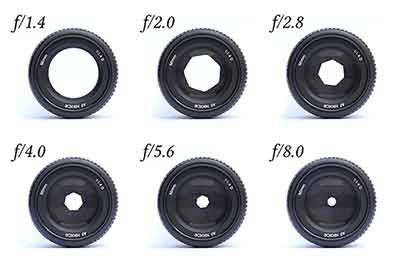
Bokeh
For those that don’t know, bokeh is the cool background blur that you see in every big YouTubers videos. It’s created when “dots of light” spread out over the entire front surface of the lens and don’t focus back down into a single point correctly.
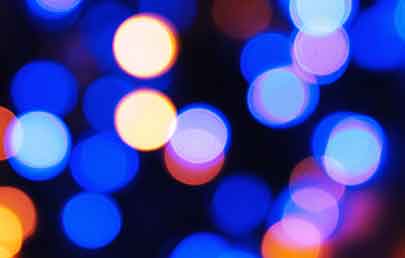
To achieve the effect you will want to purchase a lens with as wide an aperture as possible. A lens with an aperture of f/2.8 is probably the highest f-number you would want to own, with lower f-numbers f/2, f/1.8, or f/1.4 being ideal.
It’s also worth mentioning that longer lenses with low f numbers can create a better-looking bokeh the further they are zoomed in. For example, a zoomed-in 50mm (f/2.8 lens) will have a more attractive background blur than a 14mm (f/2.8) lens.
Unfortunately, buying a lens with a longer zoom does come at a price, as zoom lenses require more expensive parts and materials. Therefore, you will find that prime lenses (no zoom) are much more affordable due to only having one focal length.
With that said, once you do know the ideal focal length for your camera lens (probably between 16-35mm), a prime lens is generally what you want anyway. On the whole, it’s unlikely you’ll be using the zoom on your camera much or even at all during a live streaming session.
3. Lenses for different sensors
When buying a camera lens, you will also need to make sure that it can fit your camera body. This is because different lenses are designed for different sensors. There are two main types of sensors; Full-frame (FX) and APS-C (DX-cropped) sensors.
Full Frame (FX)
A full-frame camera has a 35mm image sensor format (36 mm × 24 mm). Lenses for these sensors are larger and subsequently more expensive.
APS-C (DX-cropped)
An APS-C camera is smaller, with an image sensor measuring (23.6mm x 15.7mm). Lenses for these sensors are often lighter and cheaper.
It’s worth noting that full-frame lenses can go onto APS-C bodies (using an adapter), however, they will be subject to the crop/ multiplication factor. The crop/ multiplication factor is somewhere between x1.5/ 1.6 depending on the manufacturer of the camera.
We won’t go into this topic in more detail, as this is further reading. To put it simply, If you have a full-frame camera, buy a full-frame lens. If you have an APS-C camera, buy an APS-C lens.
What is the best lens for streaming with a Sony Mirrorless camera?
APS-C Lenses
3. Sony E PZ 16-50mm – f/3.5-5.6
Ideal for shooting wider shots, many streamers producing video content use the Sony E PZ as their main lens. Thanks to the versatility of the zoom and the low f-number, this lens lets you capture a lot more of your video content than a “standard” 50mm lens ever would.
The show-stopping tech on this lens though is the image stabilization technology. The internal focus and retractable design guarantee that you always stay in frame. You won’t have to worry about sudden movements that might throw off your focus when broadcasting.
The seven-blade circular diaphragm of this lens produces a clean and crisp video and gently blurs anything out of focus. This will add to the production quality, improving shots while reducing the amount of heavy lifting in post. Lightweight and compact, it pairs nicely with other Sony gear.
Britny Ellen uses this lens for streaming.
2. Sony 35mm – f/1.8
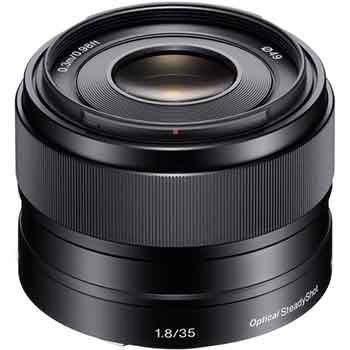
It’s the extra-low dispersion (ED) glass on this lens that makes the Sony SEL35F1 a premium choice. Engineered to eliminate a lot of chromatic aberration, ED glasses produce better contrast and color even when you open up the aperture. This is great for those searching for sharper image quality.
Speaking of the aperture, the circular aperture design of this lens is special, too. Instead of creating a blocky, almost polygonal diffusion at the extreme edges of your video, it’s capable of a softer diffusion that looks more natural and professional.
Built with several Gyro sensors into the lens, the SEL35F18 does a fantastic job at automatically detecting motion and stabilizing your video. There’s nothing more off-putting for an audience than having to experience frequent motion blur, which is exactly what this lens specializes to counteract.
1. Sigma 16mm – f/1.4
Those looking for a high-quality prime lens to stream with will love this Sigma option. The fixed focal length guarantees a super sharp image, though you will have to give up the ability to zoom. Still, due to the follow-focus technology, the image clarity this lens produces is absolutely top-shelf.
The wide-rounded diaphragm on this lens is another component that helps improve its streaming quality. That’s going to produce a little bit of bokeh or blurring in the out-of-focus regions of your videos. Additionally, it will help to produce a higher-contrast video in much lower lighting.
When attached to a Sony mirrorless camera, you’ll be able to shoot stunning HD video that won’t require a lot of post-processing, either. The aperture lets in lots of extra light and the reasonably wide-angle of view helps with staging. In short, it’s one of the best streamer lenses around.
Optimum Tech uses the Sigma 16mm.
Full Frame Lenses
3. Sigma 50mm – f/1.4
The Sigma 50mm F/1.4 provides a razer sharp image, awesome bokeh, and little to no distortion or vignette that a human being would notice. Moreover, the autofocus capability means you’ll be able to set it up and forget your camera so you can focus on entertaining an audience.
We also like that this lens does well to deal with chromatic aberration. Only extreme lighting situations are going to throw off the color and contrast of the video when using this lens. Strong backlighting can affect things as well, but that won’t be so much of a problem for streaming.
This lens is particularly bulky so you’ll probably want to make sure that it lives permanently in a stationary camera setup. Either use it as a “multi-angle” streaming lens that you can cut to every now and again, or as your direct, primary lens – but make sure it’s a bit further back.
Random Frank P uses this lens.
2. Tamron 28-75mm – f/2.8
Plenty of people swear by the 28-75mm Tamron lens as the “gold standard” for streaming, and for a couple of reasons. The autofocus technology is fantastic, and the way that it works with Sony cameras (particularly mirrorless) is often even better than the Sony-branded lenses themselves.
Constructed with a hardened anti-reflection glass lens that all but eliminates ghosting and flaring, you know you’re getting the highest quality. Being a zoom lens it is larger than some of the other alternatives, however, that comes with the added benefit of being able to fine-tune the focal length.
If you do what to adjust the focal length quickly, the Tamron features a high-speed zoom. Although most streamers won’t likely be zooming in and out all that regularly, you’ll appreciate it if you ever need to take some photographs of products.
Whether you’re shooting close-up shots at a wide-angle or landscapes from further away, this is the only lens you need.
Hardware Canucks uses this lens.
1. Sony 16-35mm – F/2.8
Those on the hunt for a quality bit of gear that won’t produce “fuzzy edges” (when shooting HD video) will adore this Sony lens. Unlike other (lesser) lenses that struggle with sharp and defined contrast, the Sony – FE 16-35mm has an optical design that improves corner-to-corner resolutions.
Sony engineers found a way to produce a lens that balances both resolution and bokeh in a video format. By taking advantage of Sony XA innovations, you get a video streaming lens that offers top-tier resolution (4K plus), minimal distortion, and a smooth blurring effect that looks very professional.
The focus on this lens is razor-sharp and there’s absolutely no chromatic aberration at all. Furthermore, the field-of-view is just wide enough to use this on a primary streaming setup without feeling like you are constantly in a close-up. The fact that it works well with so many Sony cameras is just another big plus.
CouRage uses this lens for streaming – (skip to 7:15).
What is the best lens for streaming with a DSLR Camera?
4. Canon 24mm – f/2.8 – APS-C
This pancake Canon lens has a 24mm “prime” focal length, which is great for streamers that are using it in a stationary configuration. You’re not going to have to worry about zoom, you’re not going to have to worry about focus problems, but you will enjoy a wide-angle of view.
As far as the aperture goes, this one is a little bit on the narrower side of things. You’ll be able to lead twice as much light as a traditional 50mm lens, though. That’s always good for streamers running their setups in darker environments so that they can focus on the action happening on screen.
The image quality is top-notch (exactly what you’d expect from the folks at Canon). There’s almost no chromatic aberration, there’s not a lot of blurring at the frame edges or corners, and you don’t have to worry about lens flare from your studio lights, either. This is a solid lens for streaming, that’s for sure.
Linus uses this lens – (skip to 6:55).
3. Nikon 35mm f/1.8 – APS-C
Even though the streaming community wasn’t as prominent around the time of this Nikon lens’s release, it still remains one of the best bits of kit on the market right now. That’s due to its solid build quality, great glass, and amazing HD video capture capabilities.
The 35mm focal length on this lens is similar to what you’d get on a 50mm from FX style cameras. It lets you get a bit of a wider-angle capture area without having to position your camera a mile away from your streaming setup. It also eliminates a lot of the perspective distortion you would find with more traditional wide-angle lenses.
Designed (with nighttime photography in mind), the aperture is superfast and allows in plenty of light. That makes it ideal for streaming studios that are always a little on the darker side of things. The autofocus is superb and the motor is near silent.
2. Sigma 17-50mm – f/2.8 – APS-C
Using the Sigma 17-55 lens, you won’t have to worry about a lot of “softness” in the corners of the shot unless you are running it “wide open”. That’s not all that uncommon with wide-angle lenses like this, but the more you stop down this lens the better the sharpness and clarity become.
Chromatic aberration isn’t a problem with this lens, either – unless the aperture is too wide, that is. You might start to see a little bit of magenta/ green CA seeping in when you run it completely open. Therefore, as long as you tighten things up a little bit the image sharpness will improve.
The great thing about this lens is that it all but eliminates the distortion a lot of other wide-angle lenses suffer from. You’ll be able to capture your whole streaming set up without things looking bendy or out of perspective. That’s a big advantage your viewers will appreciate.
Overall, it’s one of the better DSLR zoom lens for live streaming purposes.
1. Sigma 18-35mm – F/1.8 for Cannon – APS-C
The Sigma 210101 is a wide-angle to normal-length zoom lens that features a fast, bright and constant f/1.8 maximum aperture. Designed specifically for APS-C sensors, it comes equipped with an 18-35mm range that’s ideal for shooting near to the subject.
The focal length on this lens makes it a fantastic choice for those people unsure of just how far they need to distance their camera. If you are going to be using it in a tight configuration, it will allow you to zoom in or out to the exact depth of field you are aiming for.
If you ever need to dial in your focus settings and “set them” permanently, we particularly like that the ultrasonic focus motor has a full-time manual override. Even with this, the autofocus is still decent for mobility, though most streamers aren’t going to be bouncing around their room that much.
At this price point – and with the kind of video this lens can capture – the trade-off is a no-brainer.
PC Centric uses this lens.
What is the best camera for live streaming?
The Sony a6400 is currently the most popular camera for live streaming. It features a 24-megapixel image sensor with a top native ISO of 32,000 (expandable to 102,400). In addition to this, It’s capable of shooting at 11fps via the mechanical shutter or up to 8fps with an electronic shutter.
The a6400 is about half the weight and size of a typical DSLR, which makes it a great choice for streamers to use as a webcam. To reduce the size and make it more compact, it sports a smaller APS-C sensor. Therefore, you can pair it with any of the APS-C Sony lenses listed above.
Sony’s state-of-the-art autofocus system is another big pro of this camera. By blending 179 phase-detect AF points and 25 contrast-detect points together, the a6400 has no problems tracking your subtle movements from left to right or even forward to back as you shift within the stream.
Any streamer or blogger knows that a fully tiltable, 180-degree touch screen is essential for self-recording. Utilizing this capability via the LCD screen makes it effortless to check-on and monitor the composition at any point throughout the creative process.
We hope you enjoyed this post on the best lens for streaming.
Click here for a list of Streaming Essentials to get you started on Twitch!
Click here for the best Lighting for Streaming!
Image Sources:
Bokeh – Photo by Alinenok on Unsplash.
Aperture – Creative Commons – https://commons.wikimedia.org/wiki/File:Lenses_with_different_apertures.jpg.
Lens – Image by Alexei Chizhov from Pixabay

